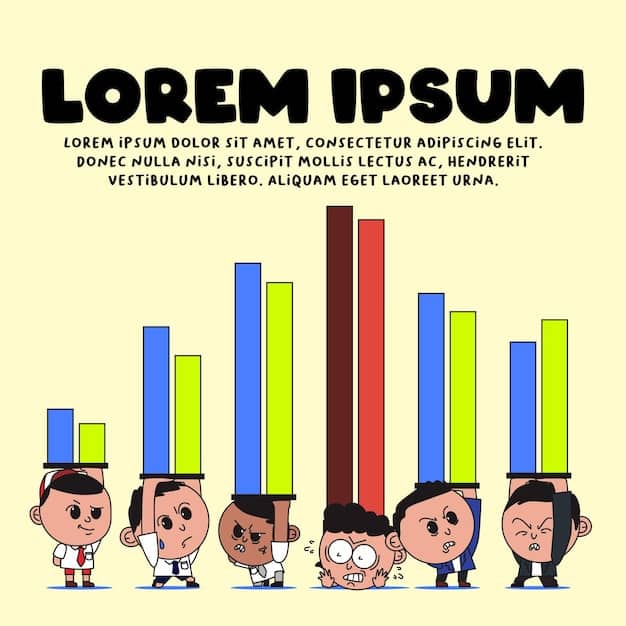J-Pop Idol Debut Ages in the US (2020-2025): A Trend Analysis

This analysis examines J-Pop idol group member debut ages in the US market between 2020 and 2025, revealing shifting trends and highlighting the intersection of age, market strategy, and cultural adaptation.
The world of J-Pop has increasingly captivated global audiences, including a growing fanbase in the US. Understanding the J-Pop Idol Group Member Ages: A Comparative Analysis of Debut Trends in the US (2020-2025) provides key insights into the strategies used to cultivate success in this competitive market.
Understanding J-Pop’s Growing Influence in the US
J-Pop, or Japanese pop music, has carved out a significant niche in the global music scene, and the US market is an increasingly important territory. The strategic deployment and marketing of J-Pop idol groups in America require understanding cultural nuances and consumer preferences.
The Rise of J-Pop in the American Music Scene
The burgeoning popularity of J-Pop in the US isn’t an isolated phenomenon; it represents a broader trend of globalization within the music industry. Thanks to social media and digital streaming platforms, J-Pop groups have been able to reach fans in the US, bypassing traditional barriers.
Key Factors Contributing to J-Pop’s American Appeal
Several factors propel J-Pop’s success in the US. The meticulously crafted performances, vibrant aesthetics, and devoted fan communities all contribute to their appeal. Furthermore, the unique blend of catchy melodies and highly choreographed dances sets it apart from other mainstream offerings.

- Enhanced Digital Accessibility: Streaming and social platforms make J-Pop easily accessible.
- Unique Visual and Performance Elements: The genre’s distinctive aesthetics and stage presence stand out.
- Dedicated Fan Engagement: Active fan communities drive enthusiasm and support.
As J-Pop gains traction, it’s essential to examine the age dynamics within idol groups targeting the US. Analyzing debut age trends can reveal strategic shifts and market projections for the future.
Analyzing Debut Ages: The 2020-2025 Window
Examining the debut ages of J-Pop idol group members is vital for understanding the strategies employed to appeal to the US market. From 2020 to 2025, there are observable trends in the age ranges of debuting idols, reflecting evolving consumer tastes and market conditions.
Common J-Pop Debut Age Ranges
Historically, J-Pop idol groups have featured members across a wide range of ages, from early teens to early twenties. However, the US market presents specific demands and preferences that impact these age demographics significantly.
Factors Influencing the Choice of Debut Age
Several factors influence the decision to debut idols at a particular age. These include the idol’s physical and mental maturity, their ability to handle rigorous training schedules, and the band’s intended market positioning and target audience.
- Market Demands: The preferences of the US audience influence age choices.
- Training Capacity: Idols must be able to manage intense training.
- Idol Maturity: Both physical and emotional maturity play key roles.
Understanding these factors gives a valuable perspective on why certain age ranges are favored and how groups adapt these choices to capture the US market.
Comparative Analysis of Debut Age Trends: US vs. Japan
Comparing debut age trends in the US and Japan provides essential insights into how J-Pop idol groups tailor their strategies for different markets. The nuances can be critical in understanding success and adoption rates.
Debut Age Variations: US vs. Japan
In Japan, it’s common to see idol groups debut members as young as 12 or 13 years old, reflecting the cultural emphasis on cultivating talent from a young age. However, the US market often prefers slightly older members, potentially due to cultural sensitivities and audience perceptions.
Reasons Behind Age Discrepancies
The discrepancies in debut ages stem from various factors, including legal regulations, cultural norms, and fan expectations. The US market is more likely to favor idols who project a level of maturity and relatability that resonates with the local audience.

Age dynamics reflect differing values and expectations among both the artists and their fans.
Understanding these deviations can help J-Pop agencies make informed decisions when launching and managing idol groups in the US.
Impact of Debut Age on Market Reception in the US
The age at which a J-Pop idol group member debuts can significantly influence how they are received in the US market. The perception of age can affect audience engagement, media coverage, and overall market penetration.
How Age Influences Audience Engagement
Younger idols may attract a youthful demographic and foster a sense of nurturing support, while older idols might appeal to a wider audience seeking maturity and sophistication. These audience preferences can dictate marketing and promotional strategies considerably.
Media Coverage and Public Perception
Age also plays a role in how media outlets and the public perceive J-Pop idols. Sensationalizing youth can sometimes create a buzz, but maintaining a positive and respectful image is crucial for long-term sustainability.
- Youthful Appeal: Attracts younger demographics.
- Broader Appeal: Older idols gain diverse audiences.
- Image Management: Maintaining a positive image is critical.
By understanding the interplay between age, market reception, and cultural context, J-Pop groups can better navigate the complex landscape of the US entertainment industry.
Case Studies: Successful Debuts in the US Market
Examining case studies of successful J-Pop idol group debuts in the US provides tangible examples of how age, strategy, and market alignment contribute to success. These examples highlight the nuances of appealing to American audiences.
Analyzing Successful J-Pop Groups in the US
Certain J-Pop idol groups have successfully broken into the US market by carefully considering the age dynamics of its members. These groups often feature a mix of members who resonate with different audience segments while maintaining a cohesive and appealing image.
Key Strategies Employed by Successful Groups
Successful J-Pop groups in the US tend to emphasize authenticity, relatable content, and active engagement with their fan base. They also understand the value of adapting their image and performance style to align with American cultural tastes.
Age versatility and strategic content creation are central to maximizing success.
These case studies offer valuable insights into how other J-Pop groups can emulate success by thoughtfully considering age dynamics and market nuances.
Future Trends: Projecting Debut Age Strategies to 2025
Looking ahead to 2025, projecting future trends in debut age strategies will be crucial for J-Pop idol groups aiming to establish a solid presence in the US market. These projections require keen insights into evolving fan preferences and industry dynamics.
Evolving Fan Preferences and Demographic Shifts
As the US market becomes more familiar with J-Pop, fan preferences are likely to evolve. The increasing demand for authenticity and diversity could influence the ideal age range for debuting idols, necessitating a more flexible approach.
Adapting to Industry Dynamics and Cultural Changes
Adapting to the changing landscape of the music industry and cultural shifts in the US will be essential for J-Pop idol groups. Understanding these shifts will enable groups to adjust their strategies and better align with market expectations.
Anticipatory planning and tactical flexibility are vital for forward progression.
By closely monitoring these trends and aligning strategies accordingly, J-Pop idol groups can enhance their appeal and resilience in the competitive US market.
| Key Point | Brief Description |
|---|---|
| 📈 Debut Age Trends | Analyzing age ranges of J-Pop idols in the US market (2020-2025). |
| 🆚 US vs. Japan | Comparative analysis of debut ages between the US and Japan markets. |
| 🎤 Market Reception | How age influences audience engagement and media coverage in the US. |
| 🌟 Successful Debuts | Case studies of J-Pop groups with successful US market debuts. |
FAQ
▼
The typical debut age for J-Pop idols in the US tends to be slightly older than in Japan, generally ranging from 16 to early 20s. This accommodates US cultural sensitivities and fan expectations.
▼
The age difference stems from varying cultural norms, laws, and fan expectations. US audiences often prefer idols who project a sense of maturity and relatability, which can influence debut age decisions.
▼
Debut age significantly influences audience engagement. Younger idols can attract a youthful demographic, while older idols appeal to a wider base seeking sophistication and experience, impacting promotional approaches.
▼
Successful strategies include emphasizing authenticity, creating relatable content, actively engaging with fans, and adapting their image to align with American cultural tastes, ensuring broad appeal.
▼
By 2025, J-Pop groups should anticipate evolving fan preferences with a growing demand for authenticity and diversity. Adaptation to industry dynamics and cultural shifts will be crucial for sustained success.
Conclusion
Analyzing J-Pop idol group member ages and debut trends in the US between 2020 and 2025 reveals a strategic interplay between cultural adaptation, market reception, and audience engagement. Understanding these dynamics is crucial for J-Pop groups aiming to establish a solid presence and achieve sustained success in the competitive US market.





